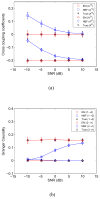Estimation of cortical connectivity from EEG using state-space models
- PMID: 20501341
- PMCID: PMC2923689
- DOI: 10.1109/TBME.2010.2050319
Estimation of cortical connectivity from EEG using state-space models
Abstract
A state-space formulation is introduced for estimating multivariate autoregressive (MVAR) models of cortical connectivity from noisy, scalp-recorded EEG. A state equation represents the MVAR model of cortical dynamics, while an observation equation describes the physics relating the cortical signals to the measured EEG and the presence of spatially correlated noise. We assume that the cortical signals originate from known regions of cortex, but the spatial distribution of activity within each region is unknown. An expectation-maximization algorithm is developed to directly estimate the MVAR model parameters, the spatial activity distribution components, and the spatial covariance matrix of the noise from the measured EEG. Simulation and analysis demonstrate that this integrated approach is less sensitive to noise than two-stage approaches in which the cortical signals are first estimated from EEG measurements, and next, an MVAR model is fit to the estimated cortical signals. The method is further demonstrated by estimating conditional Granger causality using EEG data collected while subjects passively watch a movie.
Figures










Similar articles
-
State-space multivariate autoregressive models for estimation of cortical connectivity from EEG.Annu Int Conf IEEE Eng Med Biol Soc. 2009;2009:61-4. doi: 10.1109/IEMBS.2009.5335049. Annu Int Conf IEEE Eng Med Biol Soc. 2009. PMID: 19965114
-
Estimation of the effective and functional human cortical connectivity with structural equation modeling and directed transfer function applied to high-resolution EEG.Magn Reson Imaging. 2004 Dec;22(10):1457-70. doi: 10.1016/j.mri.2004.10.006. Magn Reson Imaging. 2004. PMID: 15707795
-
Estimation of the time-varying cortical connectivity patterns by the adaptive multivariate estimators in high resolution EEG studies.Conf Proc IEEE Eng Med Biol Soc. 2006;2006:2446-9. doi: 10.1109/IEMBS.2006.260708. Conf Proc IEEE Eng Med Biol Soc. 2006. PMID: 17946513
-
Exploring directed functional connectivity based on electroencephalography source signals using a global cortex factor-based multivariate autoregressive model.J Neurosci Methods. 2019 Apr 15;318:6-16. doi: 10.1016/j.jneumeth.2019.02.016. Epub 2019 Feb 25. J Neurosci Methods. 2019. PMID: 30817942
-
Assessing recurrent interactions in cortical networks: Modeling EEG response to transcranial magnetic stimulation.J Neurosci Methods. 2019 Jan 15;312:93-104. doi: 10.1016/j.jneumeth.2018.11.006. Epub 2018 Nov 12. J Neurosci Methods. 2019. PMID: 30439389 Free PMC article.
Cited by
-
Disrupted directed connectivity along the cingulate cortex determines vigilance after sleep deprivation.Neuroimage. 2013 Oct 1;79:213-22. doi: 10.1016/j.neuroimage.2013.04.103. Epub 2013 May 3. Neuroimage. 2013. PMID: 23643925 Free PMC article.
-
Network modeling of dynamic brain interactions predicts emergence of neural information that supports human cognitive behavior.PLoS Biol. 2022 Aug 18;20(8):e3001686. doi: 10.1371/journal.pbio.3001686. eCollection 2022 Aug. PLoS Biol. 2022. PMID: 35980898 Free PMC article.
-
Bridging M/EEG Source Imaging and Independent Component Analysis Frameworks Using Biologically Inspired Sparsity Priors.Neural Comput. 2021 Aug 19;33(9):2408-2438. doi: 10.1162/neco_a_01415. Neural Comput. 2021. PMID: 34412115 Free PMC article.
-
Spectral and spatial changes of brain rhythmic activity in response to the sustained thermal pain stimulation.Hum Brain Mapp. 2016 Aug;37(8):2976-91. doi: 10.1002/hbm.23220. Epub 2016 May 11. Hum Brain Mapp. 2016. PMID: 27167709 Free PMC article.
-
Context-specific differences in fronto-parieto-occipital effective connectivity during short-term memory maintenance.Neuroimage. 2015 Jul 1;114:320-7. doi: 10.1016/j.neuroimage.2015.04.001. Epub 2015 Apr 9. Neuroimage. 2015. PMID: 25863155 Free PMC article.
References
-
- Lutkepohl H. Introduction to Multiple Time Series Analysis. 2. Berlin: Springer-Verlag; 1993.
-
- Bressler S, Richter C, Chen Y, Ding M. Cortical functional network organization from autoregressive maodeling of local field potential oscillations. Statist Med. 2007;26:3875–3885. - PubMed
-
- Ding M, Chen Y, Bressler L. Granger causality: Basic theory and application to neuroscience. In: Schelter B, Winterhalder M, Timmer J, editors. Handbook of Time Series Analysis. Vol. 17. Weinheim: Wiley; 2006. pp. 437–459.
-
- Bernasconi C, Konig P. On the directionality of cortical interactions studied by structural analysis of electrophysiological recordings. Biol Cybern. 1999 Sept;81(3):199–210. - PubMed

